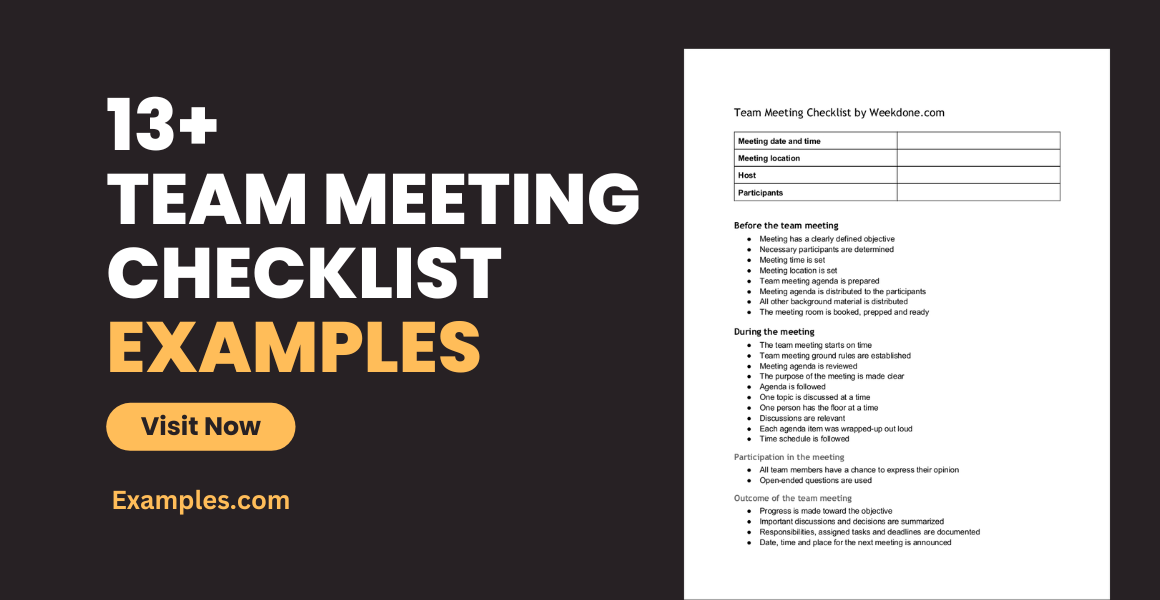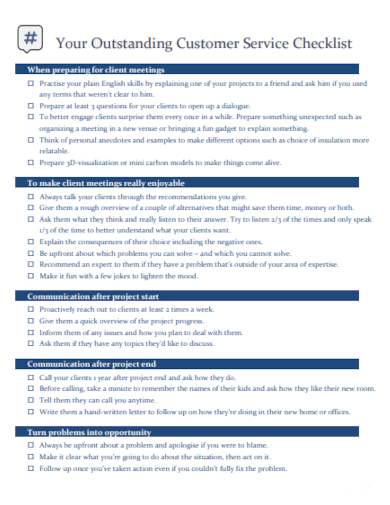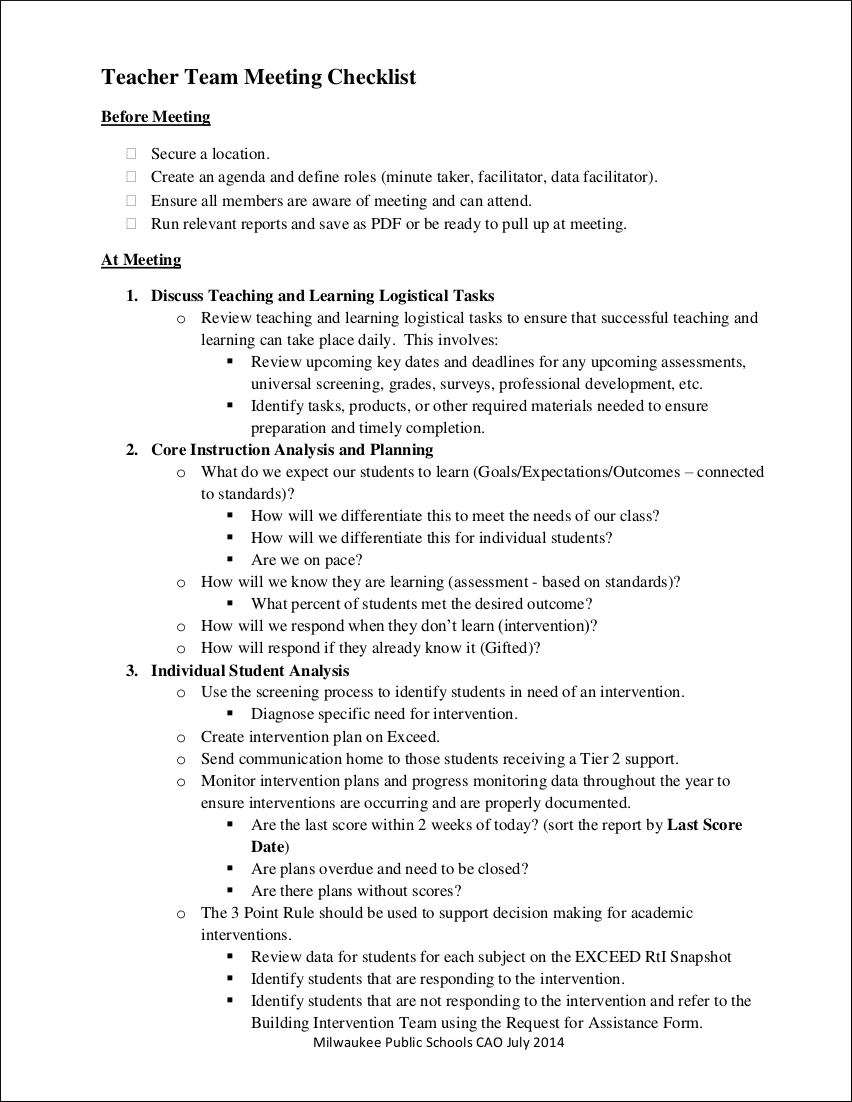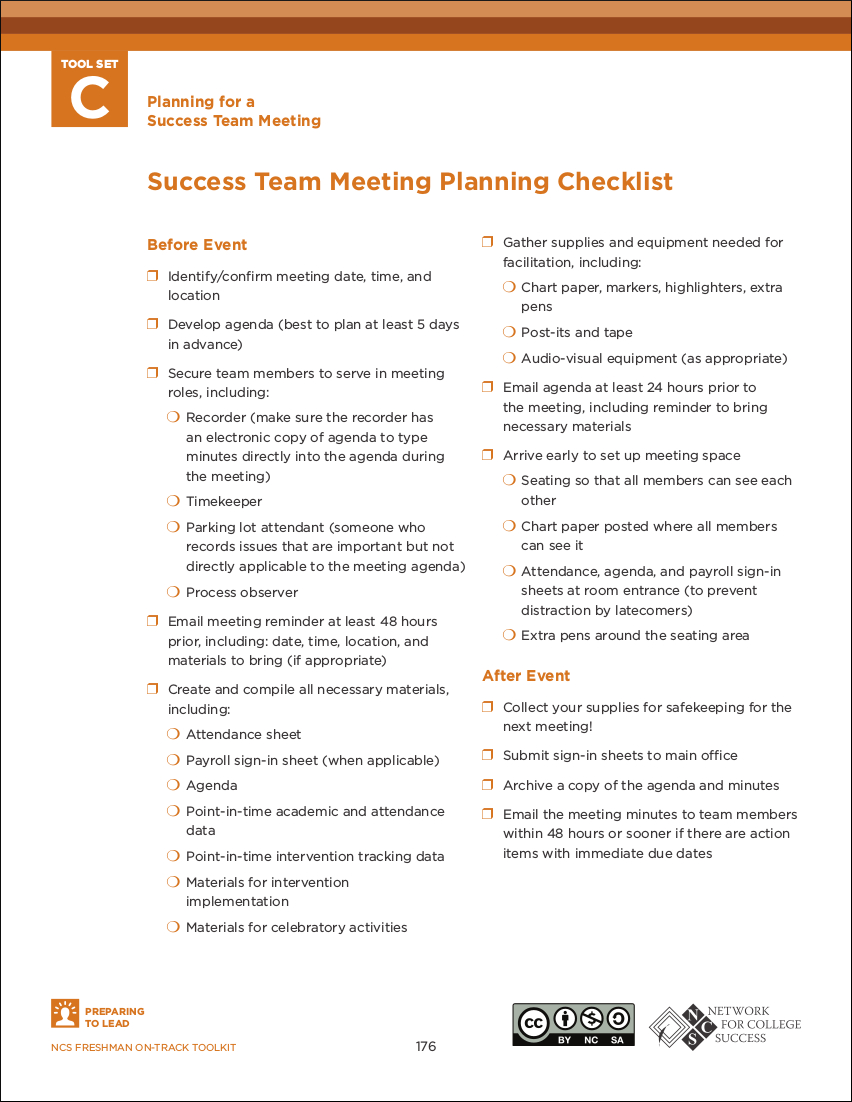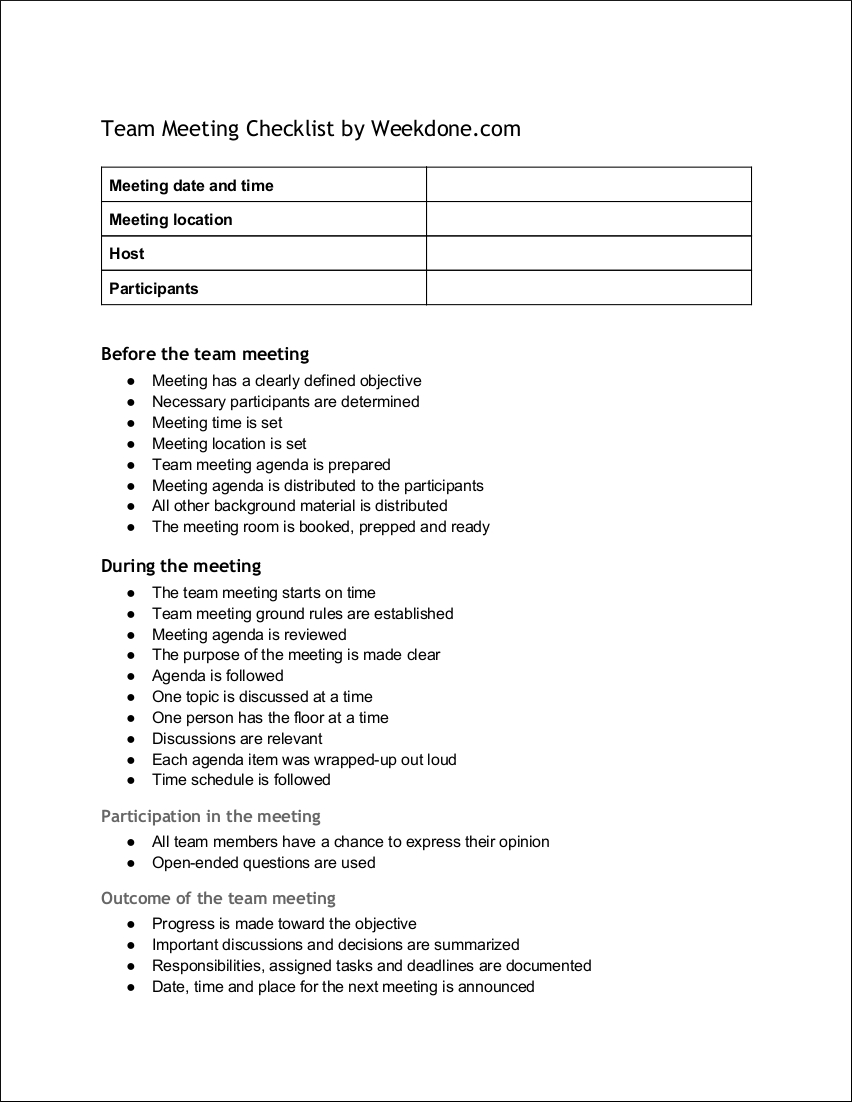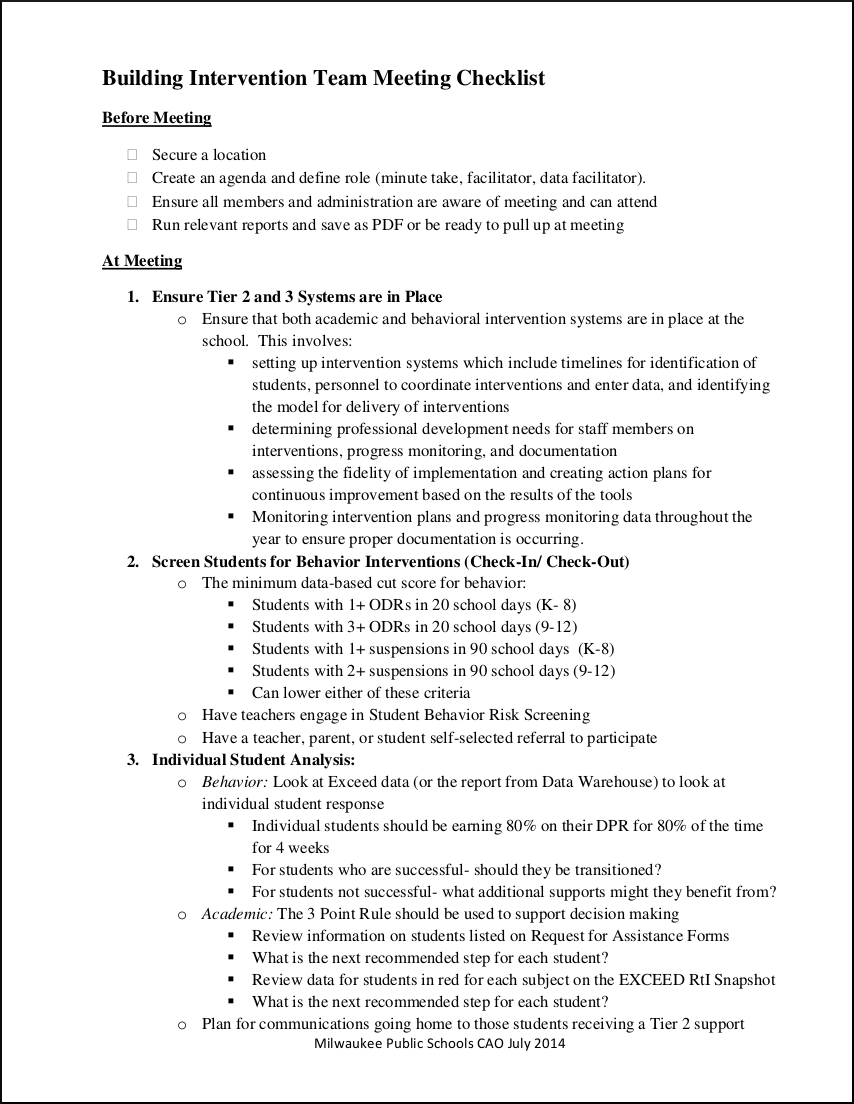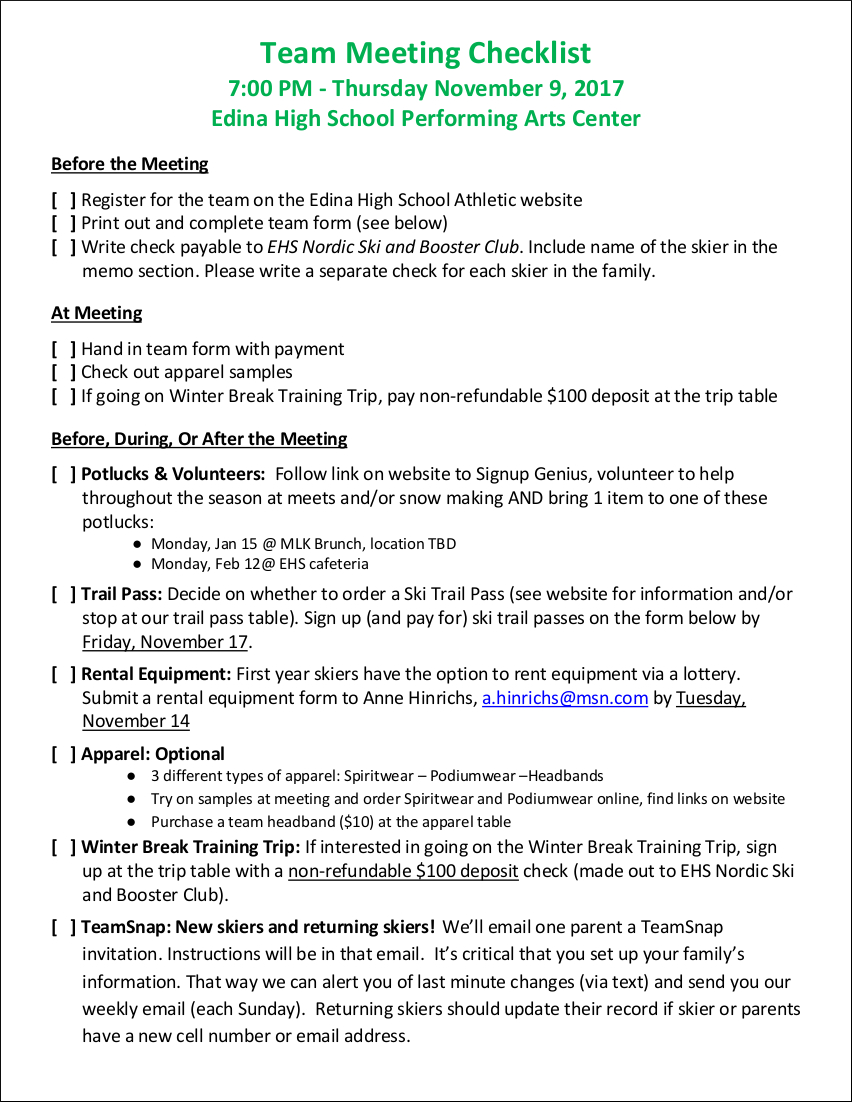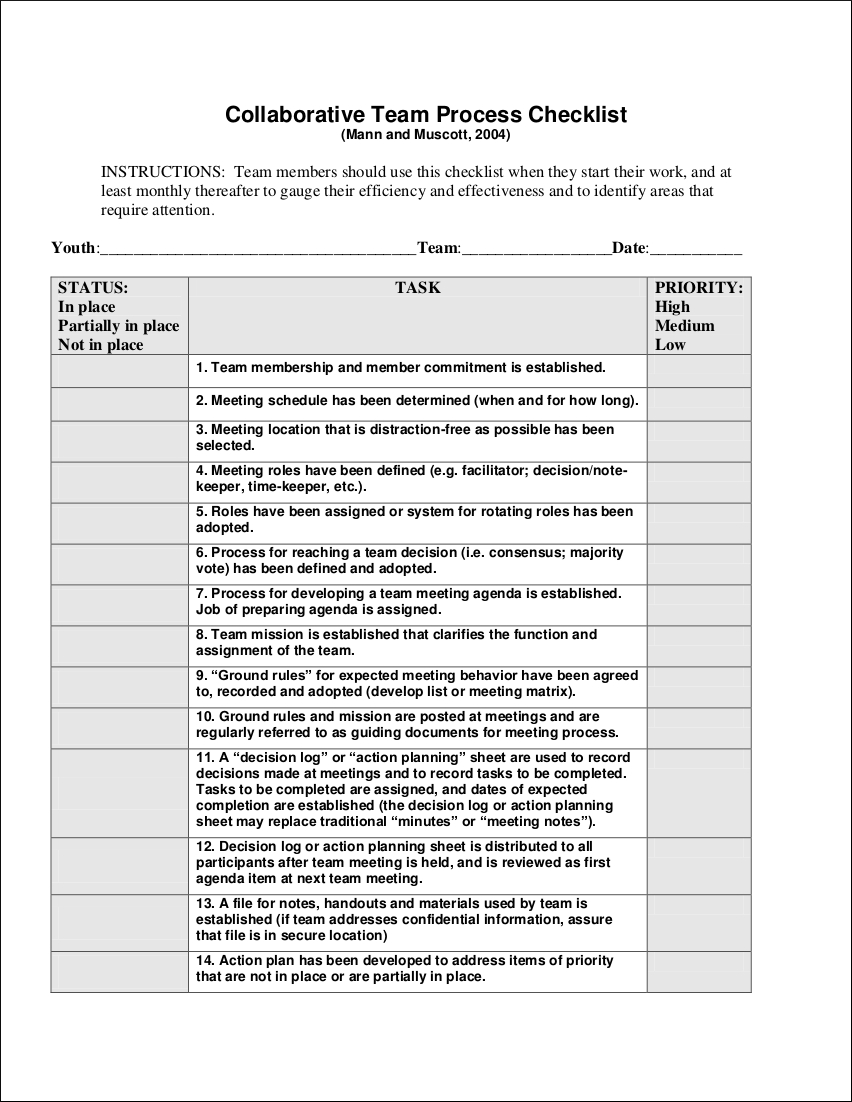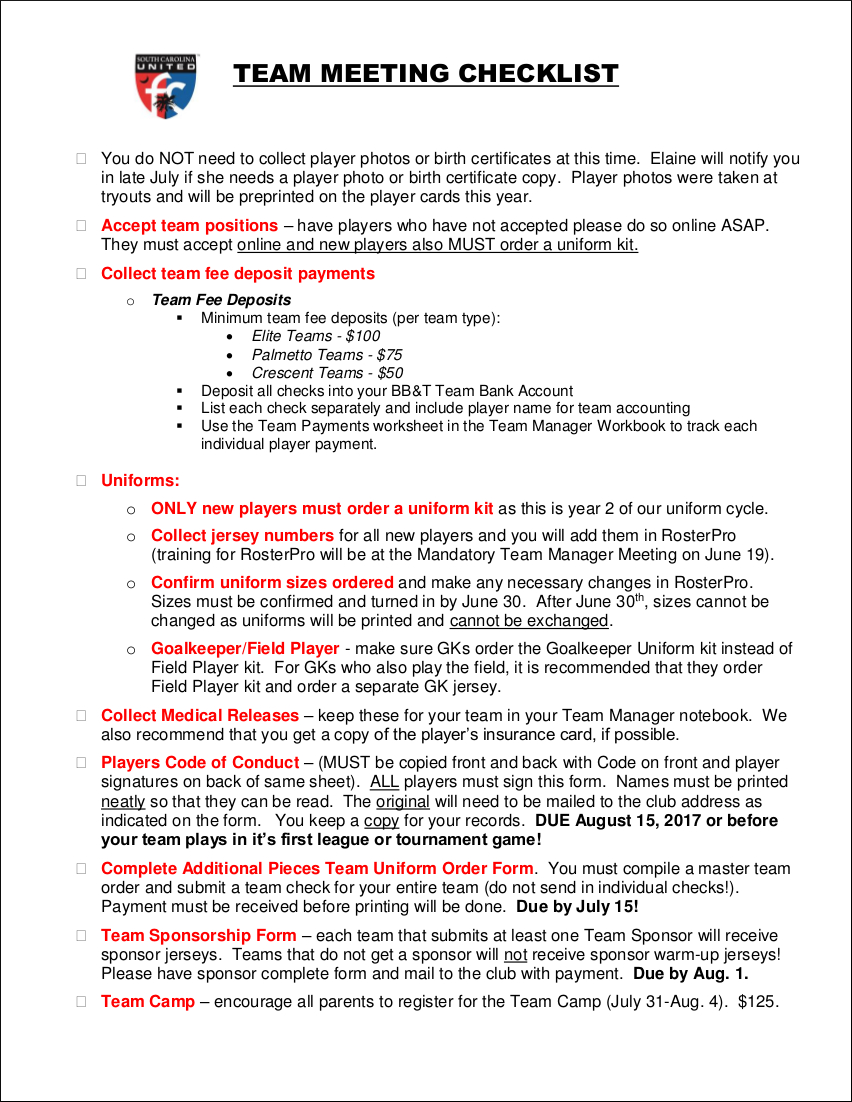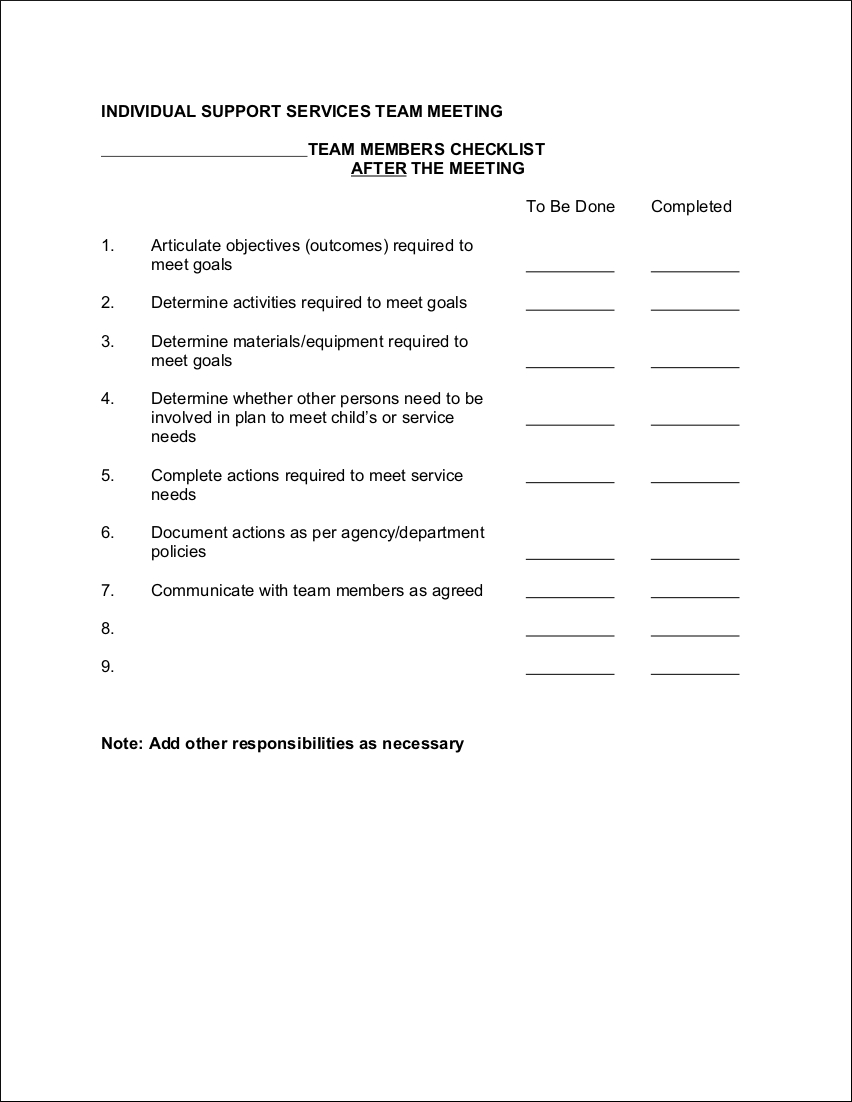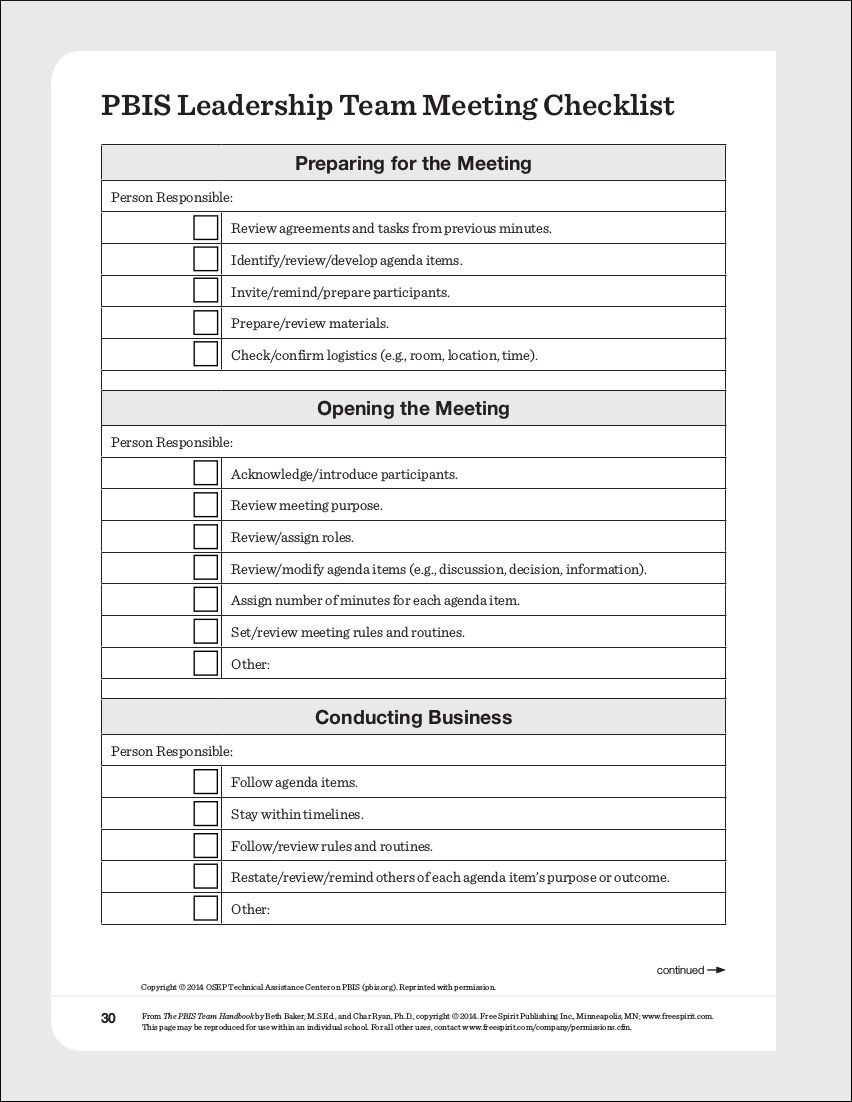Team Meeting Checklist
Every meeting counts since it serves as the platform where team members can address previous issues or create calls to action to help them achieve the objective of the team or even the company in the future. With all the thing things that are needed to be discussed during a team meeting, it is essential for the meeting schedule and processes to be organized in a professional manner. Using a team meeting checklist can help the entire team put all the subjects of discussion into perspective.
What is in a Team Meeting Checklist?
There are different formats and structures that an organization can come up with when developing a team meeting checklist. Moreover, this document can also be done by secretaries and point persons only when needed and necessary. Even if there are a lot of ways that a team meeting checklist can be created, there are some information that are essential to be found in every team meeting checklist. fA basic team meeting checklist includes the following information:
- The purpose or the agenda for an effective meeting
- The date and time of the meeting
- The location where the meeting will be held
- The items that are necessary to be prepared for the meeting
- The presentations that will be shown during the meeting
- The technical support needed for the team meeting, if applicable
- The subjects of discussion that should be given focused on
- The reevaluation of the previous minutes of the meeting
- The people who are expected to be present during the team meeting
- The specific tasks of the meeting attendees
- The call to actions that are needed to be discussed
- The dissemination of the meeting notice
These details can sometimes be added or removed in the team meeting checklist that the company will use. As we have mentioned, these are essential parts of a team meeting checklist, but it still depends on the entity who will use it on whether they will include all of these items or not.
What is the Best Examples of Team Meeting Checklist?
Here is an Examples of Team Meeting Checklist:
Pre-Meeting Preparation:
- Define the meeting’s purpose and objectives.
- Create a clear and concise agenda.
- Distribute the agenda and any pre-read materials in advance.
- Confirm the meeting logistics (time, place, virtual link).
- Set up necessary technology and tools for presentation or collaboration.
- Prepare a list of participants and confirm attendance.
Starting the Meeting:
- Begin on time to respect everyone’s schedule.
- Review the meeting agenda and objectives for the meeting.
- Establish ground rules for discussion if necessary.
During the Meeting:
- Facilitate the discussion to stay on topic.
- Encourage participation from all members.
- Take notes or assign a note-taker for action items and decisions.
- Address each agenda item with allotted time frames.
- Use visual aids or handouts if needed to support points.
- Keep track of time to ensure all items are covered.
Action Items and Decision Making:
- Clearly state action items and assign responsibilities.
- Set deadlines for action items.
- Document decisions made during the meeting.
Closing the Meeting:
- Summarize key points, decisions, and next steps.
- Confirm understanding and agreement among team members.
- Express appreciation for the team’s contributions.
- Schedule the next meeting date and time.
- End the meeting on time.
Post-Meeting Follow-Up:
- Distribute meeting minutes promptly.
- Follow up on action items and ensure accountability.
- Provide additional information or clarification as requested.
- Evaluate the meeting’s effectiveness and seek feedback for improvement.
This checklist ensures that team meetings are well-organized, focused, and productive, leading to tangible outcomes and enhanced team collaboration.
Team Meeting Preparation Checklist Example
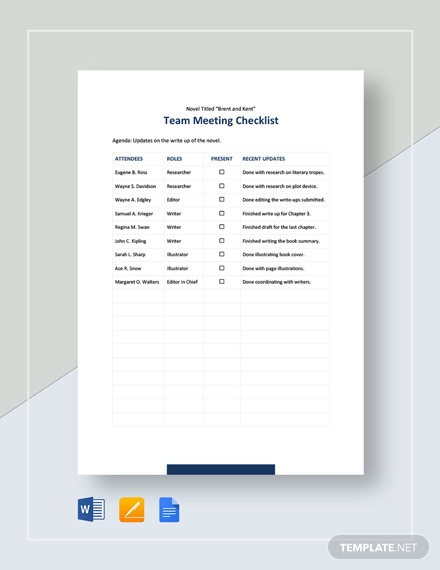
Meeting Preparation Checklist Template Word
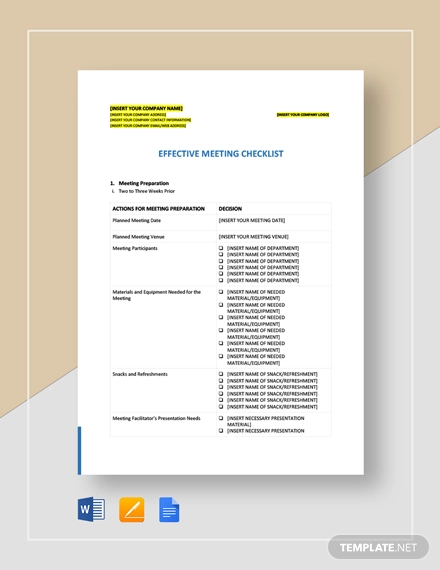
Team Meeting Agenda Template Format
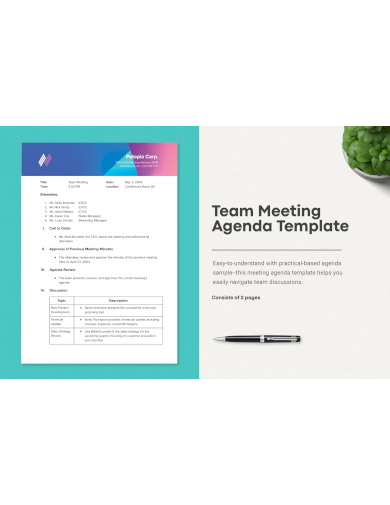
Customer Service Team Meeting Checklist
The ability to create a comprehensive team meeting checklist can bring a lot of advantages to the entire team. Each team member has a particular work function to do every time they go to the office, which is why the time that they will allot for a meeting discussion should not be wasted. If you want to know more information about a team meeting checklist and how you can create one, referring to existing samples can help you a lot.
What to Include in Team Meeting?
Here is an Elements to Include in Team Meeting:
Key Elements to Include in a Team Meeting:
Agenda:
- Clearly defined topics for discussion
- Time allocations for each team agenda item
Objectives:
- Specific goals for the executive meeting
- Desired outcomes or decisions to be made
Updates:
- Progress reports on ongoing projects
- Recent developments or changes impacting the team
Action Items:
- Review of tasks assigned in previous meetings
- Distribution of new tasks and responsibilities
Problem-Solving:
- Identification of current challenges or issues
- Collaborative brainstorming for solutions
Decision-Making:
- Key decisions that need team input or consensus
- Voting or consensus-building activities if necessary
Feedback and Input:
- Opportunities for team members to share ideas and feedback
- Open floor for suggestions or concerns
Recognition:
- Acknowledgment of achievements or milestones
- Praise for individual or team accomplishments
Professional Development:
- Discussion of training, workshops, or learning opportunities
- Sharing of industry news or updates relevant to the team’s work
Next Steps:
- Summary of action items and owners
- Deadlines and timelines for deliverables
Meeting Evaluation:
- Quick feedback on the meeting’s effectiveness
- Suggestions for improving future meetings
Scheduling:
- Confirmation of the next meeting date and time
- Pre-planning for future agenda items
Incorporating these elements can help ensure that team meetings are productive, collaborative, and effective in driving progress.
Formal Teacher Meeting Preparation Checklist
Team Meeting Planning Checklist Example
Team Meeting Agenda Ideas and Points:
Here is a Good Ideas and Points for Team Meeting Agenda:
Welcome and Introductions:
- Greet attendees and introduce any new team members or guests.
- Brief icebreaker activity to foster team cohesion (for new teams or when new members join).
Review of Previous Meeting:
- Recap the last meeting’s action items and their current status.
- Acknowledge completed tasks and discuss any pending issues.
Project Updates:
- Progress reports from team members on ongoing projects.
- Highlight milestones reached and acknowledge individual or team efforts.
Key Performance Indicators (KPIs) Review
- Analyze current KPIs against targets.
- Discuss strategies for areas falling short of goals.
Upcoming Projects and Initiatives:
- Introduction of new projects or initiatives.
- Meeting Outline objectives, timelines, and expected outcomes.
Challenges and Solutions:
- Open discussion on challenges faced by the team.
- Collaborative problem-solving session to find viable solutions.
Resource Allocation:
- Review current resource distribution and identify any needs or excesses.
- Plan for optimal resource utilization moving forward.
Training and Development:
- Identify upcoming training opportunities.
- Discuss skill gaps and potential development plans.
Innovation and Ideas:
- Brainstorming session for new ideas to improve processes or products.
- Encourage creative thinking and idea sharing.
Health and Safety Brief:
- Update on health and safety protocols (particularly relevant in certain industries).
- Discuss any recent incidents and lessons learned.
Customer Feedback and Insights:
- Share recent customer feedback and discuss implications for the team.
- Plan for improvements based on customer insights.
Recognition and Rewards:
- Celebrate team and individual achievements.
- Announce any rewards or recognition given since the last meeting.
Open Forum:
- Allow team members to bring up any topics not covered in the agenda.
- Encourage open dialogue and address any concerns.
Action Items and Wrap-Up:
- Summarize decisions made and action items assigned.
- Confirm understanding and commitment to next steps.
Closing Remarks:
- Thank team members for their participation and contributions.
- Provide motivation and positive reinforcement for the work ahead.
Next Meeting:
- Set the date and time for the next meeting.
- Request input for items to include in the next agenda.
A well-structured agenda like this can help ensure that team meetings are efficient, productive, and engaging, leading to better team performance and morale.
Importance of Using a Team Meeting Checklist
A team meeting checklist is only a small and simple document. However, using one can provide a lot of benefits to the entire team and the business. If all items in relation to the meeting will be placed in a single working checklist, then it will be easier for the meeting attendees to be knowledgeable of the entirety of the meeting’s processes and activities. Here are some of the reasons why using a team meeting checklist is very important:
Conducting effective team meetings is crucial for any organization. A team meeting checklist serves as a pivotal tool to ensure that every session is productive, time-efficient, and aligned with the team’s goals. Here’s why incorporating a team meeting checklist is indispensable:
Ensures Preparation:
A checklist prompts team members to come prepared. It can include items like reviewing the agenda, preparing updates, and brainstorming solutions in advance. This preparation leads to more engaged and productive meeting discussions.
Promotes Structure and Focus:
With a checklist, meetings have a clear structure. It helps keep the conversation on track and focused on the objectives, reducing the chances of the meeting veering off into irrelevant topics.
Enhances Efficiency:
Checklists can significantly cut down on wasted time by streamlining the meeting process. By following a structured plan, teams can address all necessary points quickly and effectively.
Encourages Participation:
A checklist can include prompts for member participation, ensuring that all voices are heard and that collaborative decision-making is emphasized.
Improves Follow-Up:
Post-meeting action items and responsibilities can be part of the checklist, ensuring that decisions lead to actions and that there is accountability for follow-through.
Facilitates Continuous Improvement:
Checklists can be updated over time to include new best practices, making them a tool for continuous improvement in the meeting process.
In conclusion, a team meeting checklist is a simple yet powerful tool to maximize the effectiveness of team interactions. By providing a clear roadmap for preparation, discussion, decision-making, and follow-up, checklists help teams work together more effectively and achieve their collective goals.
Sample Team Meeting Preparation Checklist
Building Team Weekly Meeting Checklist
What is the purpose of Team Meetings?
Here is a Purpose of Team Meetings:
Aligning on Goals and Objectives:
Team meetings bring everyone onto the same page regarding the team’s short-term and long-term goals. They ensure that each member understands the objectives and their role in achieving them.
Tracking Progress and Performance:
Regular meetings allow teams to review progress on projects, discuss key performance indicators, and adjust strategies as needed to stay on track.
Facilitating Communication:
Meetings provide a forum for open communication, allowing team members to share information, give updates, and voice concerns in a collaborative environment.
Problem-Solving and Decision-Making:
When issues arise, team meetings offer a platform to brainstorm solutions, make collective decisions, and agree on the best course of action.
Fostering Team Cohesion and Collaboration:
By bringing team members together, meetings can strengthen relationships, enhance understanding, and foster a sense of unity and collaboration.
Encouraging Innovation and Creativity:
Meetings can be an incubator for new ideas, where team members feel encouraged to think creatively and propose innovative solutions.
Providing Recognition and Boosting Morale:
Recognizing individual and team achievements in meetings can boost morale and motivate members to continue producing high-quality work.
Addressing Administrative and Operational Needs:
Team meetings can serve to disseminate important administrative information, discuss operational changes, and ensure compliance with organizational policies.
Planning and Resource Allocation:
They are essential for meeting planning future work and ensuring that resources are allocated efficiently to meet the team’s needs.
Building a Culture of Accountability:
Regular meetings establish a rhythm of accountability, where team members are expected to report on their responsibilities and progress.
Enhancing Adaptability:
In a rapidly changing work environment, team meetings help members adapt by discussing changes and recalibrating their approach as necessary.
Ensuring Safety and Compliance:
For certain industries, team meetings are crucial for discussing safety protocols, ensuring compliance with regulations, and maintaining a safe work environment.
Team meetings, when conducted effectively, are a critical component of successful team management. They help to ensure that everyone is working cohesively towards common goals, leading to improved productivity and job satisfaction.
Team Conference Room Checklist Example
Team Meeting Preparation Checklist Example
Factors to Consider When Creating a Team Meeting Checklist
All the things that make up the entirety of the team meeting checklist should be prioritized so proper cohesion can be achieved during the actual meeting. The factors that you need to consider when creating a meeting checklist include the following:
- Purpose of the Meeting: Clearly define the objective of the meeting. Is it for decision-making, brainstorming, status updates, or problem-solving?
- Attendees: Consider who needs to be present. Including only relevant participants ensures efficiency and focused discussions.
- Agenda Clarity: Ensure the agenda is specific, clear, and sent out in advance. This helps attendees prepare and understand the meeting’s focus.
- Time Management: Allocate time slots for each agenda item to keep the meeting concise and on track.
- Roles and Responsibilities: Assign specific roles like facilitator, note-taker, and timekeeper to streamline the process.
- Participant Engagement: Plan for ways to engage all attendees, ensuring everyone has the opportunity to contribute.
- Materials and Resources: Identify and distribute any necessary pre-meeting materials for review to help attendees come prepared.
- Technology Needs: If using virtual meeting tools, ensure all participants have access and understand how to use them.
- Action Items and Follow-up: Include a process for summarizing decisions, assigning action items, and outlining follow-up steps.
- Feedback Mechanism: Incorporate a method for collecting feedback on the meeting’s effectiveness and areas for improvement.
- Flexibility: Be prepared to adjust the checklist as needed based on the meeting dynamics and feedback from team members.
- Cultural and Linguistic Considerations: Acknowledge and accommodate any cultural or language differences among team members.
- Legal and Ethical Compliance: Ensure the meeting note content and conduct comply with relevant legal and ethical standards.
Sample Team Meeting Checklist in PDF
Team Meeting Checklist for Administration Assistant
Guidelines in Creating an Effective Team Meeting Checklist
It is true that using a checklist improve efficiency. If you will make one, the entire team can be affected in a positive manner. Creating a team meeting checklist depends on the needs of the team or the demands of the management on what should be brought up during a particular discussion. Even if there are no general formats that you need to consider, you still need to be aware of the things that can affect the effectiveness of the team meeting checklist that you will create. A few of the guidelines that can help you create an effective team meeting checklist are as follows:
- Define Clear Objectives: Determine the purpose and goals of the meeting to guide the content of your checklist.
- Outline the Agenda: List all topics to be discussed, including time allocations for each item.
- Assign Roles: Designate a meeting leader, note-taker, and timekeeper to ensure structured proceedings.
- Prepare Materials: Ensure all necessary documents or reports are prepared and shared with attendees beforehand.
- Set Ground Rules: Establish rules for engagement, such as speaking one at a time or limiting discussions to agenda items.
- Facilitate Participation: Include prompts or sections in the checklist to encourage input from all participants.
- Monitor Time: Keep track of time spent on each agenda item to avoid overruns and ensure efficiency.
- Focus on Actionable Outcomes: Ensure that discussions lead to clear decisions, actions, or next steps.
- Summarize and Recap: End the meeting with a summary of decisions made and action items assigned.
- Distribute Meeting Minutes: Share a concise summary of the meeting, including key points and responsibilities.
- Set Date for Next Meeting: If needed, agree on the date and time for the next meeting.
- Solicit Feedback: After the meeting, ask participants for input on the checklist’s effectiveness and areas for improvement.
- Revise and Update: Regularly update the checklist based on feedback and changing team needs.
Leadership Team Management Meeting Checklist
Team Board Meeting Commitment Checklist
How to Write a Meeting Checklist?
Here is an instructions for writing a Meeting Checklist:
Define the Meeting’s Purpose:
- Clearly state the objective of the meeting.
- Determine if the meeting is necessary to achieve the objective.
Prepare the Agenda:
- List all topics to be discussed.
- Allocate time for each agenda item.
- Identify and list key decisions that need to be made.
Choose Participants:
- Identify who needs to be in the meeting.
- Ensure all necessary stakeholders are included.
Logistics:
- Set the date and time for the meeting.
- Choose a suitable location or virtual meeting platform.
- Arrange for necessary equipment (projector, whiteboard, etc.).
Pre-Meeting Communication:
- Send out the agenda and any pre-reading materials in advance.
- Provide clear instructions on how to join the meeting if it’s virtual.
- Confirm attendance.
Assign Roles:
- Designate a facilitator to guide the meeting.
- Assign a note-taker to document discussions and decisions.
- If needed, identify a timekeeper to keep the meeting on track.
During the Meeting:
- Start the meeting on time.
- Review the agenda and objectives at the start.
- Facilitate discussions and manage time effectively.
- Ensure all voices are heard and all items are covered.
Conclude the Meeting:
- Summarize key points and decisions.
- Clarify action items and assign responsibilities.
- Agree on deadlines for action items.
- Set the date for the next meeting if necessary.
Post-Meeting Actions:
- Distribute meeting minutes promptly.
- Follow up on action items.
- Store meeting records for future reference.
Review and Improve:
- Gather feedback on the meeting’s effectiveness.
- Reflect on what worked well and what could be improved.
- Adjust future checklists based on feedback.
A well-crafted meeting checklist is a tool that ensures meetings are productive, efficient, and serve their intended purpose. It acts as a guide to keep the meeting focused and on track, from the planning stage through to the follow-up actions.
How to Create a Team Meeting Checklist
Just as how writing a meeting agenda can be done in a fast manner, the development of a team meeting checklist is also easy if you are aware of the things that the team would like to achieve for a specific meeting or team discussion. How you create a team meeting checklist can affect its efficiency when used. This is the reason why you have to be keen when making the team meeting checklist that you and your group will use. The steps that you may follow in creating a team meeting checklist are listed below.
Creating a comprehensive team meeting checklist is a strategic step toward enhancing the productivity and effectiveness of your meetings. Here’s a detailed guide on how to create this essential tool, complete with key headings for easy understanding.
Understand the Meeting’s Purpose:
- Identify the Objectives: Start by defining what you want to achieve with the meeting. Whether it’s project updates, brainstorming sessions, or decision-making, knowing the purpose shapes your checklist.
Draft a Basic Structure:
- Set the Agenda: Outline the main topics to be discussed. Include time allocations for each item to manage the meeting duration effectively.
Pre-Meeting Preparations:
- Assign Roles: Decide who will lead the meeting, take notes, and manage time. Assigning roles ensures smoother flow and accountability.
- Distribute Materials in Advance: Share relevant documents, reports, or updates before the meeting, so team members come prepared.
During the Meeting:
- Start with a Quick Recap: Begin with a summary of the agenda and objectives. This sets the tone and focus.
- Time Management: Stick to the allocated times for each agenda item. This keeps the meeting on track and respects everyone’s time.
- Encourage Participation: Ensure everyone has the opportunity to speak. This could be through round-table updates or open discussion segments.
Decision-Making and Problem-Solving:
- Facilitate Collaborative Decisions: Use this section of the checklist to guide the team through decision-making processes, ensuring all opinions are considered.
Conclude Effectively:
- Summarize Key Points: End with a recap of decisions made and action items assigned.
Post-Meeting Follow-Up:
- Distribute Meeting Minutes: Share a summary of the meeting, including action items and deadlines, for reference and accountability.
- Set the Next Meeting Date: If applicable, decide on the next meeting date to maintain momentum.
Review and Update the Checklist:
- Gather Feedback: After the meeting, ask for feedback on the checklist’s effectiveness and areas for improvement.
- Make Necessary Adjustments: Update the checklist based on feedback to continuously improve the meeting process.
By following these steps, you can create a team meeting checklist that will serve as a vital tool for enhancing the efficiency and productivity of your team meetings. This checklist not only provides structure but also ensures that meetings are more focused, inclusive, and actionable.
Difference Between Staff Meeting and Team Meeting?
Staff meetings and team meetings are both important gatherings in the workplace, but they serve different purposes and are structured differently. Below is a comparative table outlining the distinctions:
| Feature | Staff Meeting | Team Meeting |
|---|---|---|
| Objective | Typically to communicate company-wide updates, policies, and overarching goals. | Focused on specific project or team-level objectives, tasks, and coordination. |
| Participants | Usually involves a larger group of employees across various departments. | Comprises members of a specific team or project group. |
| Frequency | Often held on a regular, scheduled basis (e.g., weekly, monthly). | Can be more flexible, scheduled as needed based on project timelines or workloads. |
| Agenda | Broad, covering multiple areas relevant to the entire staff. | Targeted, dealing with issues directly relevant to the team’s work. |
| Content | May include financial reports, HR updates, new hires, company achievements, and compliance issues. | Usually includes task progress, problem-solving, brainstorming, and role-specific updates. |
| Discussion | Tends to be more one-way, with management communicating to staff, though it may include a Q&A segment. | Encourages interactive dialogue, collaboration, and sharing of ideas among team members. |
| Decision-Making | Decisions are generally made by the leadership and communicated during the meeting. | Decisions often arise from group discussions and consensus among team members. |
| Duration | May be longer due to the breadth of topics covered. | Typically shorter and more focused, with a tight agenda. |
| Outcome | Aims for alignment and consistency across the organization. | Aims for clarity on immediate next steps and problem resolution. |
| Formality | More formal, reflecting organizational hierarchy and protocol. | Can be informal, emphasizing teamwork and collaboration. |
| Documentation | Formal minutes are often recorded and distributed organization-wide. | Action items and decisions may be noted, with a focus on distribution to team members. |
Understanding the differences between staff and team meetings can help employees prepare appropriately and contribute effectively. While staff meetings align the larger group towards common organizational goals, team meetings dive into the specifics of executing these goals at the team level.
What should be included in a meeting checklist?
A meeting checklist should include the meeting’s purpose, a detailed agenda, a list of participants, logistics (time, location, equipment), pre-meeting communications, assigned roles (facilitator, note-taker), key topics for discussion, action items, decision-making processes, summary of outcomes, post-meeting follow-ups, and a schedule for the next meeting if needed.
Who should prepare the Team Meeting Checklist?
The Team Meeting Checklist should be prepared by the meeting’s organizer or facilitator, often in collaboration with team leaders or managers. This person is responsible for ensuring that the meeting’s objectives are clear and that all necessary preparations are made to facilitate a productive discussion.
How do you structure a weekly team meeting?
Start with a brief check-in or icebreaker. Review the agenda and objectives. Discuss progress on ongoing tasks and address any roadblocks. Share updates and celebrate wins. Explore upcoming projects and deadlines. Allocate time for open discussion and problem-solving. Assign action items and responsibilities. Conclude with a recap and confirm the next meeting.
What should be covered in a team meeting?
In a team meeting, cover progress updates, upcoming project timelines, individual and team achievements, any roadblocks or issues, collaborative problem-solving, action items from previous meetings, new action items and responsibilities, feedback and open discussion, and planning for future agendas. Ensure to leave room for questions and clarifications.
How do you make an agenda for a team meeting?
Identify the meeting’s purpose. List key topics and objectives. Allocate time for each item. Include progress reviews, new initiatives, and open discussions. Assign presenters for each topic. Add a segment for action items and next steps. Distribute the agenda in advance to allow team members to prepare.
What to include in a staff meeting agenda?
Include a welcome note, review of previous meeting action items, departmental updates, discussion of new business, policy changes, employee recognition, open forum for staff concerns, training opportunities, health and safety updates, upcoming events, action items recap, and details for the next meeting in a staff meeting agenda.
When should the Team Meeting Checklist be distributed?
The Team Meeting Checklist should be distributed well in advance of the meeting, ideally at the same time as the meeting agenda. This allows team members sufficient time to prepare, ensuring they can contribute effectively and that the meeting runs smoothly and efficiently.
Conclusion:
Based on the items that we have discussed, it is truly easy to create a team meeting checklist. Whether you will create a meeting email sample or a physical meeting checklist document, all you need to do is to be well-prepared and knowledgeable of the document’s creation. Communicate with all the entities involved in the meeting so you can ensure that all their needs will be addressed. More so, always be organized when developing the document.
With available tips and downloadable samples, it will be more efficient on your side to create a team meeting checklist. May it be for a group of four or for a big team, having this document can help you achieve the team meeting’s objective. Create one now and see what we mean.


